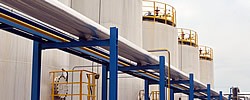Naco Lubrication Co. and Lu’an Group are building a plant in China’s Shanxi Province that will use coal-to-liquids feedstock to manufacture polyalphaolefins for synthetic lubricants. The PAO facility is scheduled to begin operations in the third quarter of 2015.
Naco, which in May opened its first PAO plant in Shanghai, said it undertook the Shanxi project to take advantage of the feedstock availability. PAO is made by assembling linear alpha olefins of certain carbon chain lengths, typically ranging from C8 to C12.
“CTL olefins are suitable for making PAOs,” Naco Marketing Manager Liu Qingcai told Lube Report Asia in an e-mail exchange. “These olefins are a local source, and we need them to help fill China’s shortage of linear alpha olefins.”
The PAO plant is located in Changzhi City and designed for capacity to make 15,000 metric tons per year of high-viscosity PAO, Liu said.
It will be the second process unit operated by the 50/50 joint venture. The first is already producing CTL solvents and olefins, and will eventually make wax, too. Construction of the PAO synthesis and hydrogenation plant began in December, two months after the joint venture was formed.
Naco believes this will be the first case of PAOs being produced using LAOs made from CTL. CTL refers to several technologies that turn coal into liquid hydrocarbons, starting by burning the coal to produce carbon monoxide syngas. The joint venture, Lu’An-Naco C1 Chemical Co. Ltd., makes LAO through a Fischer-Tropsch process using an iron-based catalyst.
One industry insider questioned the efficiency of the PAO project. Amy Claxton, principal of My Energy, a U.S. consultancy on base stocks and lubricants, noted that the technology used by Lu’An’s CTL plant is an indirect liquefaction process. There are other categories of CTL technologies that do not use Fischer-Tropsch, including direct coal liquefaction; and coal-to-chemicals, which first turns coal gas to methanol and then transforms the methanol to olefins and other chemicals.
“I was surprised to see that this site would be producing olefins at all, much less producing PAO, as there are already several methanol-to-olefins plants running in China where I think it would be cheaper to get olefins,” Claxton said in an e-mail exchange. She also suggested that linear alpha olefins can be used to make products that are higher in value than PAOs. “I can't get too excited about CTL PAOs. If this joint venture makes a little PAO, great. If they make a lot, they won't be able to sell it.”
The Changzhi PAO plant will be optimized for making a 150 centiStoke viscosity grade that is wholly intended for China’s internal market, and especially for premium diesel engine oils, explained Liwen Wei of Novitas Chem Solutions. Meanwhile, he added, Naco’s first PAO plant will celebrate with an official opening ceremony in Shanghai on October 24.
Novitas, which is based in Bellaire, Texas, U.S.A., is the North American marketer of material from Naco’s Shanghai facility, including 40 and 100 cSt PAO and an alkylated naphthalene.
Lu’an is one of China’s five largest coal companies. It began working on its CTL plant in 2008 and last year opened a pilot plant.
Source : Lube Report


